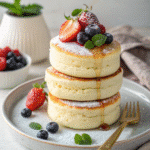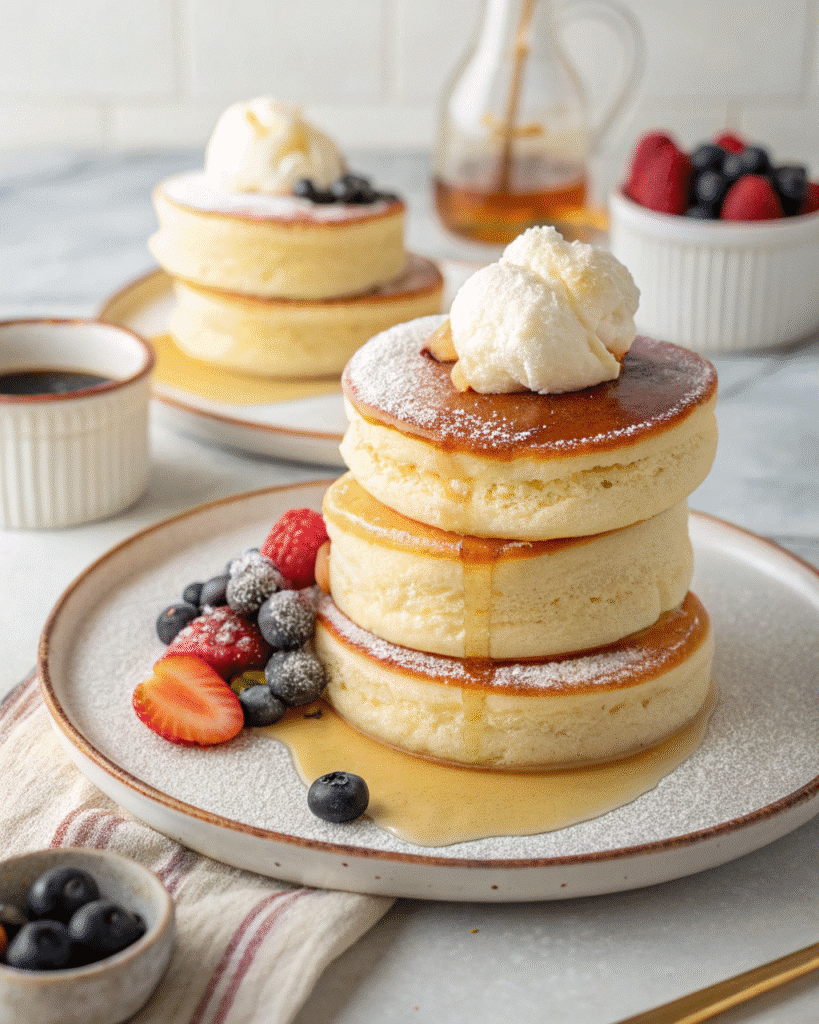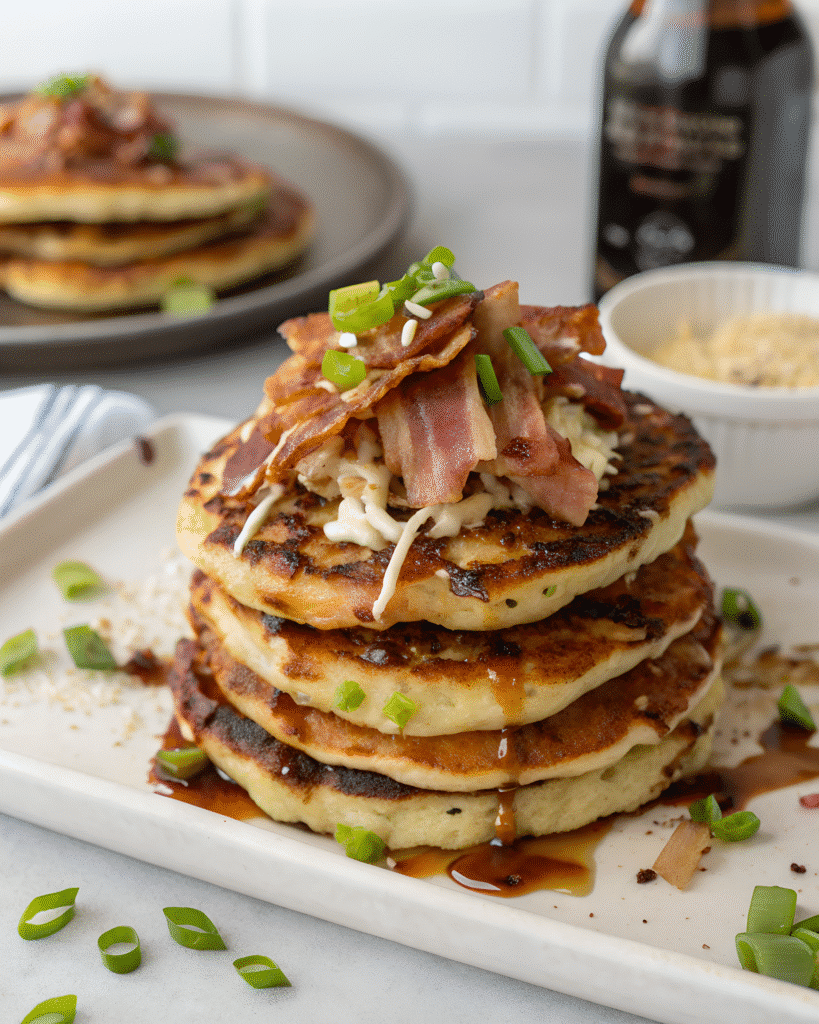Table of Contents
Table of Contents
Introduction
Hi, I’m Alice from Deliciousavors.com! My kitchen memories began in Madison, Georgia, but it was a Tokyo café where I first tasted authentic Japanese pancakes airy, soufflé-style clouds one day, savory okonomiyaki another. Here’s a quick recipe: For soufflé pancakes, whisk 2 egg yolks with 1.5 tbsp milk, fold in 1/4 cup cake flour and 1/2 tsp baking powder. Whip 2 egg whites with 2 tbsp sugar until stiff, then gently fold into yolks. Spoon onto a low-heat skillet, cover, steam with a splash of water, and cook until tall and golden. Serve with syrup or whipped cream Southern heart, Japanese soul.
Print
Japanese Pancake: Ultimate Guide to 3 Styles, Best results
- Total Time: PT0H30M
- Yield: 2-3 servings
Description
Delight your family with two legendary Japanese pancakes: fluffy soufflé pancakes perfect for breakfast or dessert, and savory okonomiyaki loaded with cabbage and your favorite toppings.
Ingredients
Soufflé Pancake:
2 eggs, separated
1.5 tbsp whole milk
1/4 cup cake flour
1/2 tsp baking powder
2 tbsp sugar
Neutral oil for cooking
Water (for steam)
Optional: whipped cream, berries, syrup

Okonomiyaki:
1 cup flour
2 eggs
3/4 cup water or dashi
2 cups finely shredded cabbage
2 green onions, chopped
Toppings: okonomiyaki sauce, Japanese mayo, dried seaweed, bonito flakes

Instructions
Soufflé Pancake:
Étape 1: Separate eggs. Whip whites with sugar to stiff peaks.
Étape 2: Combine yolks, milk, flour, baking powder.
Étape 3: Gently fold whites into yolk mixture.
Étape 4: Oil skillet, use low heat, spoon batter in rounds.
Étape 5: Add water to the pan, cover, cook until tall and golden.
Étape 6: Top with cream, berries, or syrup.
Okonomiyaki:
Étape 1: Mix flour, eggs, and water/dashi until smooth. Rest batter.
Étape 2: Fold in cabbage and green onion.
Étape 3: Pour into skillet, cook until golden on one side.
Étape 4: Flip, finish cooking.
Étape 5: Top with sauces, mayo, bonito, and seaweed.
Notes
For soufflé pancakes, do not overmix; patience creates rise. For okonomiyaki, experiment with your favorite proteins or cheese.
- Prep Time: PT0H15M
- Cook Time: PT0H15M
- Category: Breakfast, Brunch or Dinner
- Method: Pan-fried
- Cuisine: Japanese
Fluffy Japanese Pancakes: A Southern Family Twist
Growing up in Madison, Georgia, Sunday mornings meant laughter and wonderful aromas wafting from our little kitchen. My mom would stand at the stove, flipping buttermilk pancakes while sharing stories about her own childhood. That warmth and those tales made each bite more special. Years later, one of my most cherished adventures was stumbling into a tiny Tokyo cafe, where I discovered Japanese soufflé pancakes. They bounced and jiggled on the plate, so tall, soft, and impossibly light. It brought me right back to the feeling of family breakfasts back home only with a Japanese spin. Here’s how you can bring a piece of that joy and curiosity to your own kitchen, with the magic of Japanese pancakes .
The Allure of Japanese Pancakes
Japanese pancakes are famous for their airy stride and tall, fluffy rise. Whether you’re craving a dessert-style soufflé pancake or a savory okonomiyaki, these dishes are all about inviting family to slow down, share, and savor a new take on breakfast or dinner. From the gentle sweetness to the savory cabbage crunch, the keyword “Japanese pancake” stands front and center as we explore both variations.
Pancakes That Tell a Story
Every pancake tells a story, whether you’re testing your first soufflé mold or tossing extra veggies into your okonomiyaki. On Deliciousavors.com, I love blending homegrown Southern comfort with global flavors. Japanese pancakes aren’t just a treat for the taste buds they’re a canvas for creativity, tradition, and new memories. From the jiggly soufflé pancake that melts in your mouth to the okonomiyaki topped as you please, you’ll find that the keyword “Japanese pancake” is your ticket to delicious surprises and cozy togetherness.
The Secrets Behind Japanese Soufflé Pancake Perfection
Fluffy soufflé pancakes have taken the world by storm, and for good reason. Their signature “cloud” texture comes from a few clever techniques and a simple ingredient list .
Building the Fluff: Egg Whites and Gentle Folds
Japanese soufflé pancakes are all about that signature fluff. The secret? Egg whites! Separate your eggs, then whip the whites with sugar until stiff peaks form. This creates the essential air structure don’t rush this step for best results. Fold the whipped whites gently into a yolk-rich batter to avoid deflating the mixture. Use a combination of whole milk, cake flour, and a touch of baking powder for just enough structure without heaviness.
Ingredients Table for Classic Japanese Soufflé Pancakes
Ingredient Amount Eggs 2-4, separated Whole milk 1.5–3 tbsp Cake flour 1/4–1/2 cup Baking powder 1/2 tsp Sugar 2 tbsp
Cooking Technique: Low and Slow
Heat control is everything. Use a non-stick skillet on the lowest setting, add the batter in rounds, cover with a lid, and sprinkle water around for steaming. This step-by-step method creates sky-high pancakes with that iconic jiggly finish. Don’t rush patience rewards you with pancakes that are truly cloudlike and unforgettable .

Savory Side: The World of Okonomiyaki Pancakes
Japanese pancakes aren’t all sweet. Okonomiyaki brings hearty, savory goodness and endless customizations a perfect dinner for families craving something different .
Okonomiyaki: A Canvas for Creativity
What is an okonomiyaki pancake? It’s a Japanese savory pancake whose name means “grilled as you like it.” The foundational batter brings together flour, eggs, dashi or water, and grated yam for extra softness if you can find it. From there, chopped cabbage stars as the core ingredient and other add-ins, like scallions, shrimp, pork, or cheese, make each version unique. Toppings are a celebration: okonomiyaki sauce, Japanese mayo, nori, and katsuobushi (bonito flakes) are traditional favorites.
Okonomiyaki Ingredient Table
Ingredient Purpose Flour (all-purpose or yam flour) Forms the batter Eggs Binds and enriches Dashi or water Adds umami and moisture Cabbage Crunch and volume Green onions Freshness
Naturally, you could pair your okonomiyaki with sides like Japanese Cucumber Salad for a complete meal.
How to Make Okonomiyaki Pancakes
Mix together your flour, eggs, liquid, and optional grated yam, then fold in finely chopped cabbage and any other fixings you love. Heat up your non-stick skillet, spread the batter into a thick round, and cook slowly first one side, then the other. Top with classic sauces and garnish. Serve hot and enjoy the wonderful blend of textures and flavors in every slice.

Fuwa Fuwa Japanese Pancakes: The Fluffiest Bite
“Fuwa fuwa” means “fluffy fluffy” in Japanese and that’s the epitome of the Japanese pancake trend. This style uses whipped egg whites and a gently steamed cook to create a soft, melt-in-your-mouth dessert or brunch centerpiece .
What are Fuwa Fuwa Pancakes Made Of?
These pancakes use similar ingredients to soufflé pancakes mainly eggs (usually separated), flour, a pinch of baking powder, sugar, and milk. The real trick is the egg whites: whip them to soft peaks, then carefully fold them in. Cook the pancakes very slowly, letting the steam from added water finish the job for a lofty rise.
Fiery Results: Soft, Tall, and Irresistible
The signature look: high, golden, and wobbly. They jostle with each poke and practically dissolve on your tongue. Enjoy them with a light drizzle of maple syrup, a dusting of confectioners’ sugar, or a scoop of fresh berries. There’s endless fun in seeing who can stack theirs the highest or who dares cut the first slice.
FAQ Section
What is a Japanese pancake called?
What is okonomiyaki batter made of?
Traditional okonomiyaki batter uses flour, eggs, dashi or water, and grated yam (if available) for extra fluff. Cabbage and other vegetables, meat, or seafood round out the mixture before it’s cooked on a griddle or skillet.
What is an okonomiyaki pancake?
An okonomiyaki pancake is a savory, customizable Japanese dish. It features a cabbage-rich batter that’s pan-fried and topped with sauces and condiments. Common in Osaka and Hiroshima but loved throughout Japan, it’s a staple comfort meal
Conclusion
Japanese pancakes are a celebration of texture and flavor one bite and you’re hooked, whether you prefer the airy soufflé, fuwa fuwa sweetness, or the savory, hearty okonomiyaki. You’ll always find the keyword “Japanese pancake” at the center of joyful kitchen moments and discovery. I hope you gather your loved ones, start flipping, and create new memories (and maybe a few stories about pancakes that didn’t quite make the stack). Next time you want a new kitchen adventure, try these iconic Japanese pancakes your table will thank you.
Article updated 27 July 2025
For more recipes, visit my Facebook page.

1 thought on “Japanese Pancake: Ultimate Guide to 3 Styles, Best results”